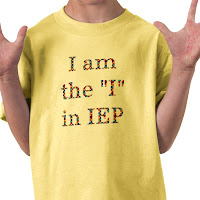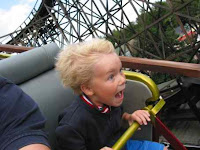"From experience with an autistic son (high functioning) with an IEP in our school district, it has been a nightmare this past school year. Due process is not at all a fair and objective process if or when you run into problems and or violations. It is costly going against county attorneys that are well versed on tactics to intimidate and bully parents in attempts to make them go away. For anyone in which the process does work, you should feel very fortunate. How can I get the IEP process to work for my child so we don't go through this terrible dilemma again next year?!"

An evaluation for your child with ASD level 1, or high-functioning autism (HFA), should determine his special education needs and will generate an appointment for a team meeting to develop an Individualized Education Program (IEP). The IEP is the document that will detail, in writing, an individualized approach to meeting the unique needs of your youngster. The team should include:
- A school representative who can make decisions about the delivery of services
- One regular education teacher
- One special education teacher
- Someone who can interpret the evaluation results as they apply to your child's educational instruction
- You and your spouse
- Other participants with special expertise or knowledge of your child
Your child may also participate if he/she chooses to be present. Participants with special expertise may include a parent-advocate knowledgeable about the IEP process, a professional consultant who specializes in developing IEPs, or a professional consultant who specializes in autism spectrum disorders. Finding a specialist can be a crucial issue, and it can be frustrating to both moms and dads and school officials when one is not accessible.
It may not be realistic to expect that an educator experienced in teaching children with Aspergers and HFA will be teaching your child. Because you know your youngster best, you may become fiercely protective and defensive of what you believe your youngster needs. On the other hand, most willing and cooperative school districts may lack such expertise and may be of the position that they are doing all they can.
If you have requested that your school district evaluate your youngster, the district must comply, and this process should be completed within sixty days after your first written request. After this, the district will ask that you sign a “Permission to Evaluate” form. The evaluation should be completed within sixty days after your original written request, not sixty days after you've signed the permission form. Once the evaluation is completed, a team meeting should be convened to review the evaluation. You should receive your youngster's evaluation well in advance of the team meeting, but no later than ten days prior to such a meeting. This team meeting may also serve as the first IEP meeting if you wish.
If your youngster has been deemed eligible for services, IEP team members should be identified, and the first meeting should occur within thirty calendar days of the original determination of eligibility. The completed IEP must then be implemented within ten school days. It must also be reviewed yearly and can be revisited in a team meeting upon your request outside of the annual meeting date. The IEP must also be in effect for your youngster at the beginning of each new school year.
The initial IEP meeting is the time and place to develop the document that will be the blueprint for your youngster's educators. The draft document should be transcribed into the final document immediately after the meeting. It should include:
- acknowledgment of your child's eligibility
- area for you to sign, acknowledging that the school district has provided you with a copy of your rights during the process, known as “procedural safeguards”
- basic information such as your contact numbers and address, your youngster's date of birth, and anticipated year of graduation
- cover sheet with a sign-in page listing all participants
- list of “special considerations,” such as visual or hearing impairment, behaviors that impede your youngster's ability to learn, and communication issues
- summary of your youngster's needs
- summary of your youngster's strengths, passions and interests
A strong IEP team should be able to find a balance between your youngster's strengths and needs. Too often, such meetings can focus upon issues that others may perceive as “behavioral” or emotional disturbances. When this occurs, teams get sidetracked and lose their focus. Teams may digress and deteriorate. Moms and dads may leave feeling angry or upset, and the self-fulfilling prophecy is perpetuated. For this reason, and particularly in very sensitive situations, it is advisable to have a professional in attendance that fits the bill of “other participants with special expertise or knowledge of your child.” In partnership with the team, this person can help keep things focused on your youngster as a youngster first and foremost.
The next step is to set IEP goals that are specific to your child's strengths and needs in order to track your youngster's educational progress and ensure that the team is implementing what it committed to doing. The goals should be realistically achievable for your youngster and written in such a way that they are easy to track or “measure,” in order to see your youngster's growth and keep the team accountable. For example, an appropriate goal for a child with Aspergers or HFA of any age might be in the area of developing computer skills. While this may sound rather generic, the spin here is to make it specific to your youngster's disorder.
The purpose of the goal should be clearly stated, such as a goal for accessing the Internet: “The child will develop skills to use a computer to communicate, to gain information, and to increase social relationships independently three out of five times.” Next, objectives to meet the goal should be identified in sequence. The sequence for the computer goal might look like this:
- The child will create and access a file and store information she wishes to save in the file.
- The child will learn methods to access social interaction through electronic media (email).
- The child will learn the functions of the computer, including turning the computer on, signing on to the Internet, and using the keyboard and other functions while exploring her passions (such as searching for information about insects as they relate to a lesson plan).
This ensures accountability as well as consistent support. A method and schedule of evaluation for each goal objective should also be included. For example, the method for the last objective listed might read, “During computer learning opportunities, the child will be afforded opportunity to increase social interactions by learning to use e-mail and other communication avenues.”
A goal for enhancing self-advocacy might address your youngster's ability to identify and communicate her sensory sensitivities in the school environment. A goal or objective might read, “The child will be able to communicate in a socially acceptable manner the specific change she requires in her educational environment four out of five times.” The method should include supporting the youngster to identify environmental stimuli that are irritants and detract from learning.
The IEP should also list “program modifications and specially designed instruction” that may include elements incorporated into goal areas, which team members should bear in mind. Such a useful list may include examples like:
- Allow extended wait time and processing time.
- Be consistent with the expectations established for the child.
- Explain directions clearly, in steps and with visual representations.
- Limit or eliminate visual and auditory stimulation and distractions in the learning setting.
- Provide advance notice of schedule and special situations.
- Provide an individual, weekly schedule to follow.
- Use photo depictions where possible instead of cartoons or drawings.
The IEP document will also indicate the projected date for implementation of services, the anticipated duration of services, and any revision dates. Specifications addressing how the school district intends to report IEP goal progress should be clearly stated. There must also be a statement reflecting why your youngster's current educational placement represents an inclusive environment as fully as possible as opposed to an alternative placement.
Some moms and dads and school districts are possessed of more experience and greater expertise in educating kids with Aspergers and HFA than others. There will always be kinks to iron out in the IEP process, and these can usually be addressed at the annual IEP meeting or at a requested reopening of the IEP. When moms and dads encounter resistance from a school district it is usually because the district:
- Doesn't “see” the challenges as a viable diagnosis
- Believes your youngster's challenges to be exclusively behavioral issues
- Believes it is meeting the goals and objectives of the IEP to its best ability
Where moms and dads resist a school's efforts, it is usually because they are extremely frustrated that the school district doesn't understand the disorder and, as a result, doesn't “get” how to educate their youngster. Ignorance can be used as an initial excuse, but it is not an acceptable long-term excuse. School districts have a responsibility to make provisions for the continuing education of educators and to seek outside technical assistance and expertise as necessary.
Moms and dads have a responsibility to serve as a resource concerning their youngster's strengths and needs, as well as to direct the district to viable resources and expertise wherever possible. When the circumstances of educating your youngster through proper implementation of the IEP goals and objectives become less than satisfactory, you have recourse available to you, provided by the IDEA law.
You may request an Impartial Due Process Hearing at any point in which disagreement arises about the delivery of education to your youngster. This includes your youngster's identification, evaluation, placement, or implementation of the IEP.
The Impartial Due Process Hearing takes place with an “impartial hearing officer.” The hearing officer is the “fact finder” who hears all the evidence and makes a ruling on the issues presented during the meeting. Such individuals are employed by your state government's education office of dispute resolution and are of varied background and position, such as former education administrators, attorneys, or psychologists.
A hearing is to be held within thirty days of the request. The school district must forward a mother/father's request to the office of dispute resolution within five days of its receipt by the district office. The hearing officer's decision must be issued within forty-five days of the request for the hearing.
There are often delays in scheduling or a hearing officer may not be timely in making his final determination to settle a dispute. During the dispute, the youngster in question is to remain in her current educational placement. The hearing officer's decision may be appealed and taken to an appeals panel within thirty days. The appeals panel must render a decision within thirty days after the review request.
Such measures will be entirely avoidable, but if a mother/father remains dissatisfied after exhausting local administrative avenues, action may be brought in any state court of competent jurisdiction or in any district court of the United States, as provided for in IDEA. There is no statute of limitations for commencing such action in federal court, but it is advisable to file as soon as possible. There may be time-frame limitations for filing a case in your state court.
Moving to file a case is stressful, frustrating, and draining for all parties involved. However, court rulings can set precedent for changes in law to the benefit of all. Any time significant change has occurred in how kids with differences are educated, it has been at the instigation of passionate moms and dads simply wanting fair and equal opportunities for their kids.
You may be a persuasive advocate when interacting with your Aspie's school district. You just may be the person to educate and enlighten the professionals in your district if they require a better understanding of Aspergers and HFA. In some extreme instances, families have moved to another school district or another state in order to have their child attend a certain school program. Unfortunately, in addition to the stress on the whole family that this type of upheaval can cause, it also allows school districts to remain uneducated about how best to support children with autism spectrum disorders.
Resources for parents of children and teens on the autism spectrum:
More articles for parents of children and teens on the autism spectrum:
Social rejection has devastating effects in many areas of functioning.
Because the ASD child tends to internalize how others treat him,
rejection damages self-esteem and often causes anxiety and depression.
As the child feels worse about himself and becomes more anxious and
depressed – he performs worse, socially and intellectually.
Click here to read the full article…
---------------------------------------------------------------
Meltdowns are not a pretty sight. They are somewhat like overblown
temper tantrums, but unlike tantrums, meltdowns can last anywhere from
ten minutes to over an hour. When it starts, the Asperger's or HFA child
is totally out-of-control. When it ends, both you and your child are
totally exhausted. But... don’t breathe a sigh of relief yet. At the
least provocation, for the remainder of that day -- and sometimes into
the next - the meltdown can return in full force.
Click here for the full article...
--------------------------------------------------------------
Although Aspergers [high-functioning autism] is at the milder end of the
autism spectrum, the challenges parents face when disciplining a
teenager on the spectrum are more difficult than they would be with an
average teen. Complicated by defiant behavior, the teen is at risk for
even greater difficulties on multiple levels – unless the parents’
disciplinary techniques are tailored to their child's special needs.
Click here to read the full article…
------------------------------------------------------------
Your older teenager or young “adult child” isn’t sure what to do, and
he is asking you for money every few days. How do you cut the purse
strings and teach him to be independent? Parents of teens with ASD face
many problems that other parents do not. Time is running out for
teaching their adolescent how to become an independent adult. As one
mother put it, "There's so little time, yet so much left to do."
Click here to read the full article…
------------------------------------------------------------
Two traits often found in kids with High-Functioning Autism are
“mind-blindness” (i.e., the inability to predict the beliefs and
intentions of others) and “alexithymia” (i.e., the inability to
identify and interpret emotional signals in others). These two traits
reduce the youngster’s ability to empathize with peers. As a result, he
or she may be perceived by adults and other children as selfish,
insensitive and uncaring.
Click here to read the full article...
------------------------------------------------------------
Become an expert in helping your child cope with his or her
“out-of-control” emotions, inability to make and keep friends, stress,
anger, thinking errors, and resistance to change.
------------------------------------------------------------
A child with High-Functioning Autism (HFA) can have
difficulty in school because, since he fits in so well, many adults
may miss the fact that he has a diagnosis. When these children display
symptoms of their disorder, they may be seen as defiant or disruptive.
Click here for the full article...









.jpg)


